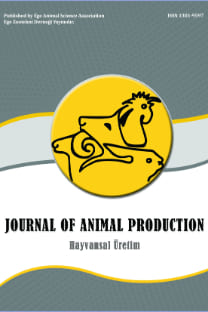Organik Etlik Piliç Karma Yemlerine İlave Edilen Yonca Ununun Performans ve Kan Değerleri Üzerine Etkileri
Bu çalışma organik yonca ununun yavaş gelişen organik etlik piliçlerin karma yemlerinde kullanılmasının canlı ağırlık, canlı ağırlık artışı, yem tüketimi, yemden yararlanma ve kan değerleri üzerine etkilerini belirlemek amacıyla yapılmıştır. Çalışmada, toplam 225 adet günlük yaşta erkek ve dişi karışık cinsiyette Red JA ırkı broyler civciv kullanılmıştır. Civcivler canlı ağırlık (CA) farklılıkları istatistiki olarak önemsiz olacak şekilde 3 muamele grubuna 5 tekerrürlü (n=15) olarak dağıtılmıştır. Muamele grupları: 1) Kontrol (Yonca içermeyen grup), 2) karma yemde %5 yonca unu içeren grup, 3) karma yemde %10 yonca unu içeren gruplardan oluşturulmuştur. Araştırma 0-77. günler arası dönemde yürütülmüştür. Karma yemlere yonca unu ilavesi yavaş gelişen etlik piliçlerde canlı ağırlığı önemli düzeyde düşürmüştür (P0.05). Yemden yararlanma muamele gruplarında kontrol grubundan daha düşük bulunmuştur (P0.05). Yonca unu ilavesi trigliserit düzeyini yükseltmiştir (P
Effects of Dietary Supplementation of Alfalfa Flour on Performance and Blood Parameters of Organic Broilers
This study was conducted to determine the effects of dietary supplementation of organic alfalfa flour on organic slow-growing broilers on live weight, live weight gain, feed consumption, feed conversion ratio and blood parameters. A total of 225 day old male and female mixed Hubbard Red JA broiler chicks were divided into 3 treatment groups with 5 replicate (n=15). The treatments were as follows; 1) control (no alfalfa ), 2) alfalfa 5% in diet, 4) alfalfa 10% in diet. The study was performed between 0 to 77 days of age. Supplementation of alfalfa to diet was decreased the live weight (P0.05). Feed convertation ratio was decreased on alfalfa supplementation groups compared lipoprotein), HDL (high density lipoprotein) and total lipids (P>0.05). Supplementation of organic alfalfa to diet was increased to the control (P
___
- A.O.A.C., 1985. Official methods of analysis, XXX edn., A. O. A. C. Publ., Washington, DC, USA.
- Castellini, C., Mugnai C., Bosco A. D. 2002. Meat quality of three chicken genotypes reared according to the organic system. Italian J. Food Sci. 14(4): 401-412.
- Carrasco, L.S.,Bellof, G. 2013. Alfalfa (Medicago sativa) meal in low energy diets of organic broiler production. conf-2013-wita.html (Erişim tarihi: 12.07.20130).
- Feedstuffs, 2005. Reference Issue & Buyers Guide. Volume: http://www.feedstuffs.com (Erişim tarihi: 22 Kasım 2011). Number: 38, performance summary,
- Tkácová, J., Angelovicová, M., Mrázová, L., Kliment, M., Král, M. 2011. Effect of Different Proportion of Lucerne Meal in Broiler Chickens. Animal Science and Biotechnologies 44(1): 141-144.
- McDonald, P., Edwards R. A., Greenhalgh J.F.D., Morgan C. A. 2002. Animal nutrition (sixth edition), Pearson Education Limited, Edinburgh Gate, Harlow, Essex CM20 2 JE 672p.
- Pedersen, M. A., Thamsborg, S. M., Fisker, C., Ranvig H., Christensen, J.P. 2003. New production system: evaluation of organic broiler production in Denmark. J. Appl. Poult. Res. 12: 493-508.
- Ponte, P. I. P., Ferreira., L. M. A., Soares, M. A. C., Aguiar, M. A. N. M., Lemos, J. P. C., Mendes I., Fontes, C. M. G. A. 2004. Use of cellulases and xylanases to supplement diets containing alfalfa for broiler chicks: effects on bird performance and skin color. J. Appl. Poult. Res. 13: 412-420.
- SAS, 1999. User's Guide. Version 8, Sas Institute, Cary, Nc.
- Schwantz, L. 2011. Chicken feed: feed recipes, rations, formulas, http://www.lionsgrip.com/recipes.html tarihi: 29 Kasım 2011). and traditional, (Erişim
- ISSN: 1301-9597
- Başlangıç: 1974
- Yayıncı: EGE ZOOTEKNİ DERNEĞİ
Sayıdaki Diğer Makaleler
Arı Ürünlerinin Hayvancılık Sektöründe Kullanımı
Banu YÜCEL, Erkan TOPAL, Mustafa KÖSOĞLU¹
Kalıtımın Epigenetik Boyutunda DNA Metilasyon Desenleri
Emine TOPARSLAN, Levent MERCAN, Mehmet KURAN
The Relationship Between Sexual Behaviors and Serum Testosterone Concentrations in Norduz Rams
Ayhan YILMAZ, Sibel ERDOĞAN, Serhat KARACA
Yapay Sinir Ağları ile Laktasyon Süt Veriminin Modellenmesi
Hande KÜÇÜKÖNDER, Mustafa BOĞA, Aykut BURĞUT, Fatih ÜÇKARDEŞ
Türkiye'de Süt Sığırcılığına Yönelik Politikalar
An Applied Method to Reduce Poverty in Rural Areas of Turkey
Elif KARAYILANLI, M Çağla Örmeci KART
Bulent KAR, Ismail AKYOL, Ugur COMLEKCİOGLU, Mehmet Sait EKİNCİ, Emin OZKOSE
